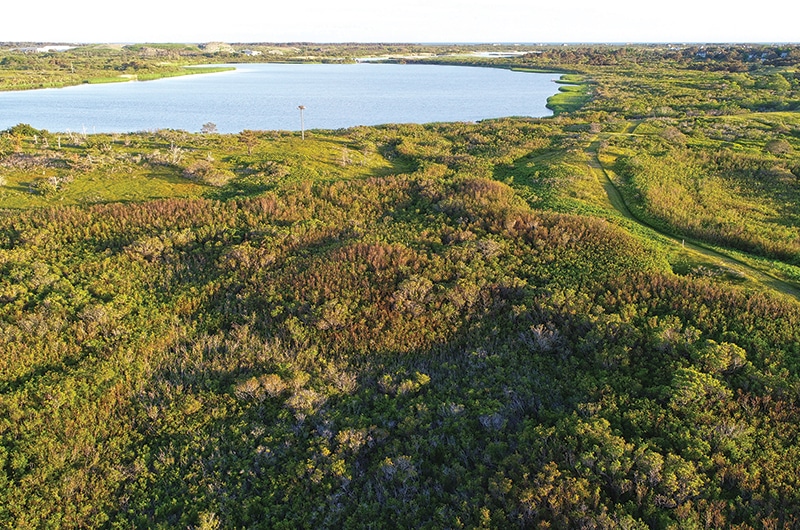by Dr. Sarah Treanor Bois
Director of Research & Education at the Linda Loring Nature Foundation
According to Wampanoag tradition, Nantucket was formed when the giant Indian, Moshaup, dumped the sand out of his moccasins at the end of a long day. The sand from one moccasin became Martha’s Vineyard and the sand from the other became Nantucket.
Today we know that Nantucket was formed by the Laurentide Ice Sheet during the last glacial stage. Where the glacier stopped its southward progression is what we call the “terminal moraine” full of glacial till. Beyond the moraine is the outwash plain. As the glacier receded, the meltwater flowed off the moraine at various points. The remainder of those water flows is what we see today as Nantucket’s long ponds: Miacomet, Hummock, Long Pond, and Madequecham Valley, among others. These ponds are all oriented north to south, sometimes connecting to the ocean.
Long Pond, on Nantucket’s west end, is a 132-acre tidally restricted brackish pond dominated by fringing wetlands. It is particularly interesting with three distinct sections: an upper pond to the north, a lower pond that is long and narrow, and a ditched marsh which eventually leads to Madaket Harbor and the ocean.
First of all is the north head of Long Pond. It is best viewed from the Linda Loring Nature Foundation property on Eel Point Road. There is no direct pond access there, but the overlook from the walking trail is a quiet place to watch the osprey fish for white perch from the nearby roost. This is a great spot for winter duck viewing, as the pond edges freeze. Snapping turtles regularly nest in the sandy banks of the paths and paper roads to the east. With only one occupied house on the whole of this portion of the pond, there is actually little human activity or input. The only public access to this portion of the pond is found along Madaket Road, across from the infamous turtle dock.
“Turtle Pond” is actually just one dock along the main portion of Long Pond. Only a culvert connects the north and south parts of the pond. Animals (such as turtles) can pass through, but the culvert is small for significant water exchange. I recently wrote about “turtle pond” and about the negative associations with feeding turtles (yesterdaysisland.com/ode-to-an-unloved-or-overloved-species). This part of Long Pond is known for its sizeable snapping turtles, but many other creatures call it home; blue crabs, white perch, ribbed mussels, hickory shad, just to name a few.
From here, the edges of Long Pond are lined with non-native invasive Phragmites australis (common reed or Phragmites). These tall reeds block watershed views and physically alter the pond edge habitat. Phragmites can tolerate brackish conditions and can be habitat for nesting birds like the Redwinged Blackbird. The monoculture the Phragmites creates, however, leaves little room for anything else.
The Nantucket Pond coalition has facilitated several Phragmites management projects on the Long Pond watershed. The initial project was around Massasoit Bridge. The success of this project led to additional phases at White Goose Cove and at various points along Long Pond funded primarily by abutting homeowners.
Moving south away from the turtle bridge, Long Pond is bordered by the Nantucket Landfill to the east. To the west, a portion of the pond takes a sharp turn. Here, the “Madaket Ditch” begins, connecting Long Pond to Hither Creek and ultimately to Madaket Harbor. This ditch was first dug in 1665 as a cooperative agreement between the English settlers and the Wampanoag as a means of more efficient fishing for herring and eel spawning. This cooperation used the Wampanoag fishing weir, but people from both groups fished and shared the spoils.
The ditch and the connection to Madaket Harbor keep Long Pond brackish. This is the only ocean connection the pond has. The ditch runs through 50 acres of saltmarsh, which serve as a nutrient sink for the pond. The marsh intercepts an appreciable amount of nutrients before they reach the creek and the harbor. The ditch flushes four times a day with the tides. It is estimated that is takes 76 days for the whole of Long Pond to turn over completely via tidal exchange.
Beyond the ditch, Long Pond meanders south, narrowing and widening along the way. It is bordered to the east by the Nantucket Islands Land Bank. The Massasoit Bridge crosses the pond at a narrow spot where it seems little more than a stream. Further south, the pond is bordered by the Nantucket Conservation Foundation on the southeast side and the Madaket Land Trust property on the north west side. Access to the pond at this end is best accomplished via Starbuck road off of Madaket road.
Overall, Long Pond benefits by the abundance of conservation land and open space directly bordering it. These lands mitigate for the potential high impact inputs of the development in other areas of Long Pond. These developments bring septic tanks and green lawns: all direct sources of nutrient loading to the pond. The other major potential impact is the Nantucket Landfill on the eastern shore. Capping and mining the landfill seem to have reduced nutrient loading into the pond from this source, but sampling by the Town continues.
To improve water quality, the Town of Nantucket (TON) recommends active land management aimed at decreasing nutrient quantity entering our ponds. The TON continues to annually sample water quality and sediment at various points of Long Pond, Hither Creek, and Madaket Harbor. It also recommends that homeowners follow the Best Management Practices for Fertilizer Use on Nantucket Island. These recommendations were put in place to help improve our water quality by reducing the loss of soil nutrients from excessive, incorrectly timed, or inappropriate fertilizers.
Another step in improving overall water quality is to maintain septic systems and replace when necessary, hooking up to TON sewer system when possible.
Finally, the TON is exploring the idea of eventually replacing the culverts throughout Long Pond to increase tidal flow and, therefore, flushing of the system.



